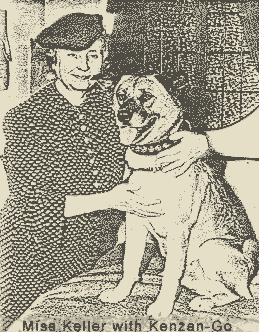 Save this page (62.6 kb)
Save this page (62.6 kb)
HELEN KELLER AND AKITAS
By Ichiro Ogasawara

During a conversation with Managing Director Matsuyama at the Headquarter's office, I mentioned that I had presented the world famous Helen Keller with Akitas on two separate occasions some thirty years ago. It was from Mr. Matsuyama's suggestion and from the urgings of several others that I relate this story to the readers as well as can be recollected.
While touring Japan, for the purpose of studying the physically handicapped and their rehabilitation, Helen Keller visited Alata City with her secretary Miss Thomson in June, 1937. She reportedly asked the official host, a member of the Board of Education, if she could be shown an Akitainu as she disembarked from the train. A member of the Board of Education asked a member of the Military Criminal Investigation Division, who, in turn, contacted me and obtained a list of Akita owners. Shortly after, however, I was contacted by telephone and informed that the Akita I introduced would not meet the requirement. It was explained that since Miss Keller was blind, it would be necessary for her to feel the dog to know what it was like. The Akitas I recommended were all grown dogs, and it was feared that there could possibly be an accident. Since I had just acquired Kamikaze-go, a two month, goma colored puppy from Mr. Takichi Takahashi, it was decided that I would show Miss Keller this puppy.
The following day, proceeding the lecture at the Akita Memorial Auditorium, I showed Miss Keller my puppy in the presence of the then Governor Homma and members of the Board of Education. Miss Keller asked me various questions about the Akitas through Miss Thomson, but as it took place such a long time ago, I could not recall the details of the conversation. All I can recall of that meeting was that she was a very warm person. At the end of the day I was visited by Mr. Ishii, Section Chief of the Board of Education who had a request from Miss Keller. Evidently, Miss Keller had fallen in love with the puppy I had shown her and wanted to take it back to the United States.
After consulting with the family, I agreed to present the puppy to her. It was arranged that I would keep the puppy for two months until Miss Keller completed her tour of Japan and Manchuria.
About a month later, however, the trip was shortened and I was notified by the Superintendent of the Board of Education that Miss Keller would be boarding the S.S. Chichibu Maru for the United States. I took the train that very night to present the puppy to her on board the ship.
After the sailing of the ship we did not hear from Miss Keller for a while, as we took it for granted that everything was fine. However, I received a letter in English, one day, and I rushed over to the Prefectural Office to have it interpreted by Mr. Yoshida, Section Chief of the Board of Education. The letter reported of Kamikaze's loyalty and the sad news that he died of distemper.
Later, in a news article, when Mr. Fleisher of the Japan Advertiser reported how Miss Keller missed Kamikaze-go, I was contacted by the Minister of Foreign Affairs, Mr. Arita, through Governor Homma and was asked to present Miss Keller with another Akita. An old friend of mine, Mr. Eijiro Kanazawa of Odate City owned Kenzan-go, a litter brother to Kamikaze. I reported back to the Minister through channels that he would be available. Thus, again, I journeyed to Tokyo to present the Akita to the Minister. I was instructed by the Administrative Assistant to take Kenzan to the S.S. Kirishima Maru and present it to the Captain of the ship the following morning.
By this time, relationships between Japan and the United States was becoming strained, and we feared that the ship would not reach the shores of the United States. However, sometime later we received word that Kenzan was safely delivered to Miss Keller through the Foreign Ministry. We also received a letter from Mr. Tahei Kobayashi, a complete stranger, who sent us clippings of photos and articles from the New York Times, reporting the arrival of Kenzan into the Port of Brooklyn. We also received photos and letters from Mill Keller thanking us for Kenzan. The New York Times also sent us the photograph that was printed in the paper. Soon after, the war broke out between Japan and the United States.
After the conclusion of the war, in the summer of 1947, out of the blue, I received a message from Miss Keller through the Mainichi Press that she had come to Japan on a speaking engagement. She was on her way to Tokyo, from Hokkaido, and wanted to meet me at Akita Station. At the appointed date, I arrived at the station a little early, and waited in the area where Miss Keller's car would stop. I remember clearly how I anxiously wondered if she would remember
me. The train finally arrived and as I worried about the short train stop, Miss Thomson spotted me and called out, "Ogasawara!" The anxiety and the span often years quickly disappeared as I hurriedly followed Miss Thomson to where Miss Keller was seated in the train. Miss Keller extended her hands and asked me about the dogs, about the situation during the war, thanked me for sending her Kamikaze and Kenzan.
Just before we said goodbye, I asked Miss Keller for her autograph and she readily complied. The meeting was a short one, and was our last meeting. Though more than thirty years have passed since these events have occurred, the memory of Miss Keller and Miss Thomson's deep love for Akitas remain fresh and deep in my heart.
(Mr. Ogasawara, having given a long and distinguished service to the organization, is one of the Vice-Chairmen of the Hozonkai as well as the Tohoku Regional Chairman)





